Elizabeth Ho's Milk Bread Doughnuts with Tea-Infused Cream
Fluffy, golden brown, and glittering with sugar, these doughnuts are a delicious showstopper
Today, I’m excited to share the first in a series of newsletters spotlighting amazing cooks and bakers. Each one will feature a recipe made in collaboration with my guest and will delve a bit into their world and how they found their way into food.
My first guest is a ray of sunshine, Elizabeth Ho (see her lovely work and newsletter here and here). Liz has a micro-bakery, Birdhouse Bakeshop, based in Edmonton from which she makes elegant cakes, cookies, madeleines, and more. Her bakes are often accented with fresh flowers and made with unique flavour profiles reminiscent of her childhood.
In this newsletter, Liz is sharing a recipe for her milk bread doughnuts: fluffy enriched doughnuts that make the ideal vessel for the second recipe, and my contribution to today’s newsletter, whipped tea-infused cream.
Before we get to the recipe, I asked Liz a few questions about her history with food and baking and the unique flavours that define her work:
Liz and I will also be hosting two cooking and baking workshops in Vancouver, BC this August. For more info, head here x
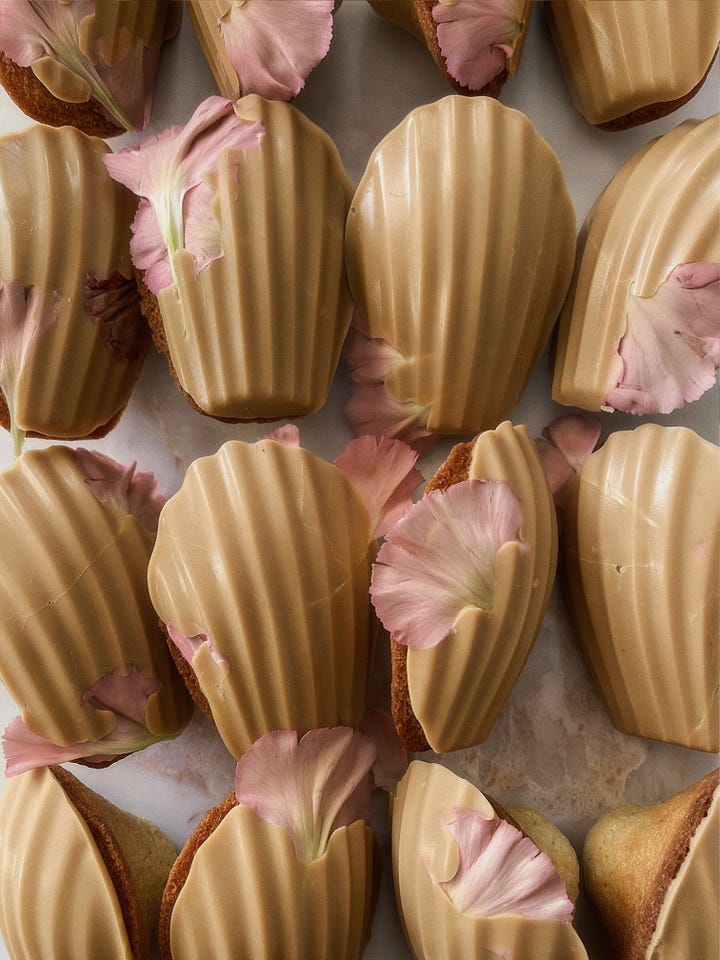
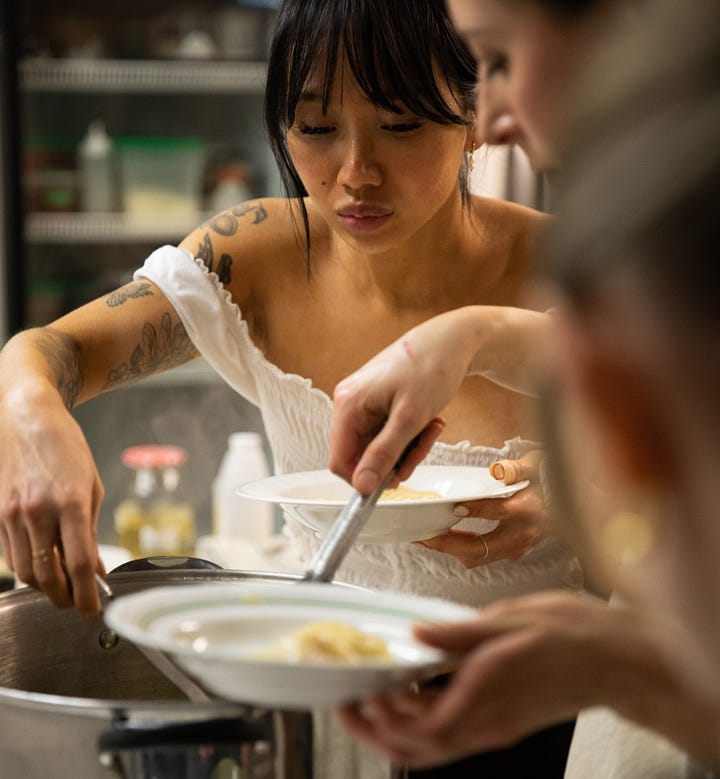
Allegra: How did you find your way into food and start Birdhouse Bakeshop?
Liz: No matter where I’ve been in life, cooking and baking has been a constant– a way of staying connected: to the seasons, to my creativity, to family traditions, and memories (while simultaneously creating new ones). Birdhouse Bakeshop began as a way to re-connect, during the pandemic– I missed feeding people! A few batches of scones a week, gifted to friends and loved ones, pretty quickly turned into a full blown microbakery..
A: What is your favourite flavour combination? Ingredient? Thing to bake?
L: I go through waves of obsession, particularly when it comes to flavours and unexpected flavour pairings; tea (to infuse creams, doughs, cakes; the possibilities are endless!) will always be my soul ingredient, I think! My favourite thing to bake might be layer cakes– it really allows me to keep a sense of wonder open, and explore levels of texture, color, depth, and inspiration!
A: I love how thoughtful your flavour combinations are. Where do you find inspiration for them and for your desserts generally?
L: I’m most often inspired by the flavours of my childhood, and my heritage, and of course the seasons! Growing up as a second generation Canadian with immigrant parents, you learn to love, and evolve with, two very different identities… I love to punctuate classically North American and European pastries in subtle, nostalgic ways– bay leaf cream in a lemon tart, milk tea in a madeleine, shiso leaf in a plum galette. It’s a small, sweet reminder of how we can be a product of many people, places, experiences, and still exist in beautiful harmony.
A: If you had one piece of advice for home bakers, what would it be?
L: Don’t be afraid to make mistakes! Failure is learning– learn to be ok with revising and rolling with the punches. Baking is not about having a perfectly stocked pantry, or having access to every fruit or specialty ingredient– get into a habit of working with, rather than against, your everyday surroundings. Sometimes your limitations turn into baking opportunities and a celebration of creativity!
Elizabeth Ho’s Milk Bread Doughnuts
Yields 14-18 doughnuts
Impossibly fluffy– these doughnuts have lightness, lift, and sweet scents of nostalgia. Wonderful on their own, or with swaths of whipped cream, but best with Allegra’s tea-infused cream.
Notes:
I prefer to begin this recipe the day or night before– allowing the dough to rest in the fridge overnight will allow the flavours to develop. But if you’re in a pinch, 2-3 hours in the fridge will work just fine (It’s a fairly sticky dough, and will be much easier to handle when cold).
Like any Shokupan recipe, this uses the Tangzhong method– it’s simply creating a roux with flour, water, and milk. Here is a rough guide, if you’re unfamiliar and want to learn more.
This will yield 14-18 doughnuts, depending on your size preference. You can roll out the dough to an inch thick, on a floured work surface, and use a cookie or doughnut cutter 2-3 inches in diameter, or roll them into balls (my preference) – use a scale, to ensure evenly sized doughnuts. Use this guide for rolling and shaping.
This recipe scales up or down well and can be halved or quartered for fewer doughnuts
Whole milk is preferable, but any milk you have in your fridge should work just as well (even a plant-based one!)
The buttermilk powder/ dry milk provides extra softness, and a “milkier” taste, but isn’t totally necessary, so feel free to omit it if you don’t have any handy.
You’ll need a kitchen thermometer, for frying/maintaining the temperature of the oil
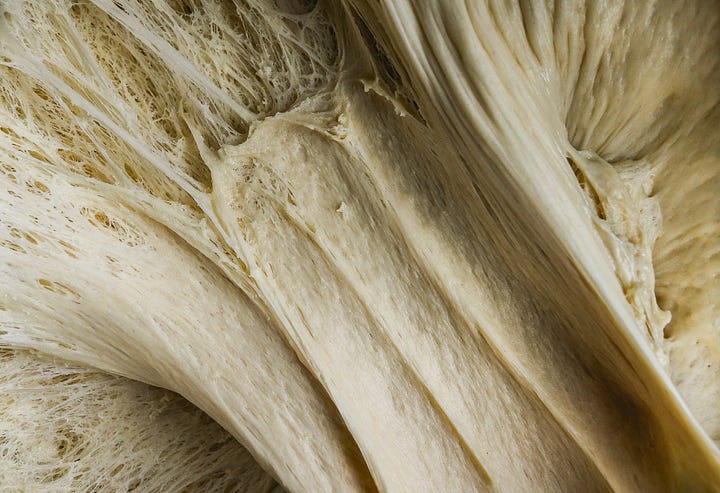
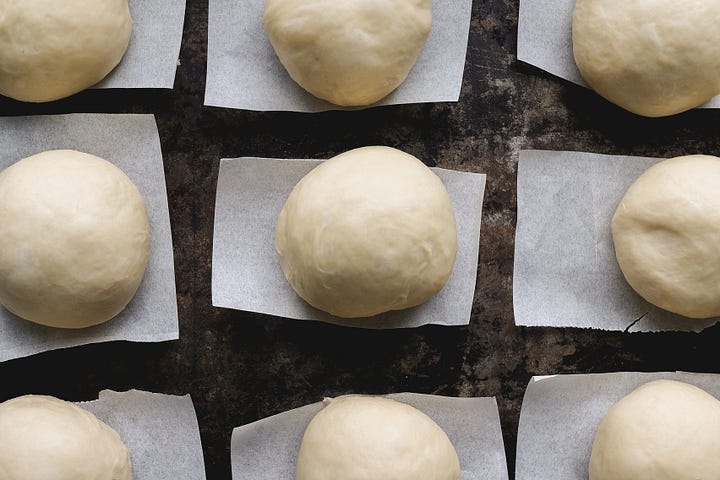
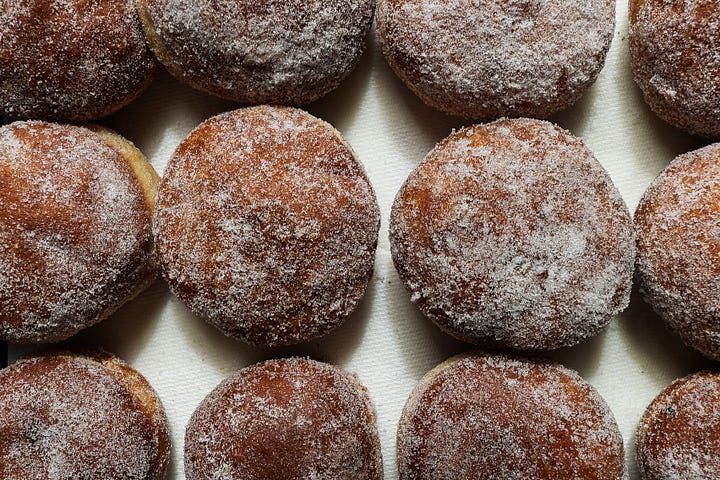
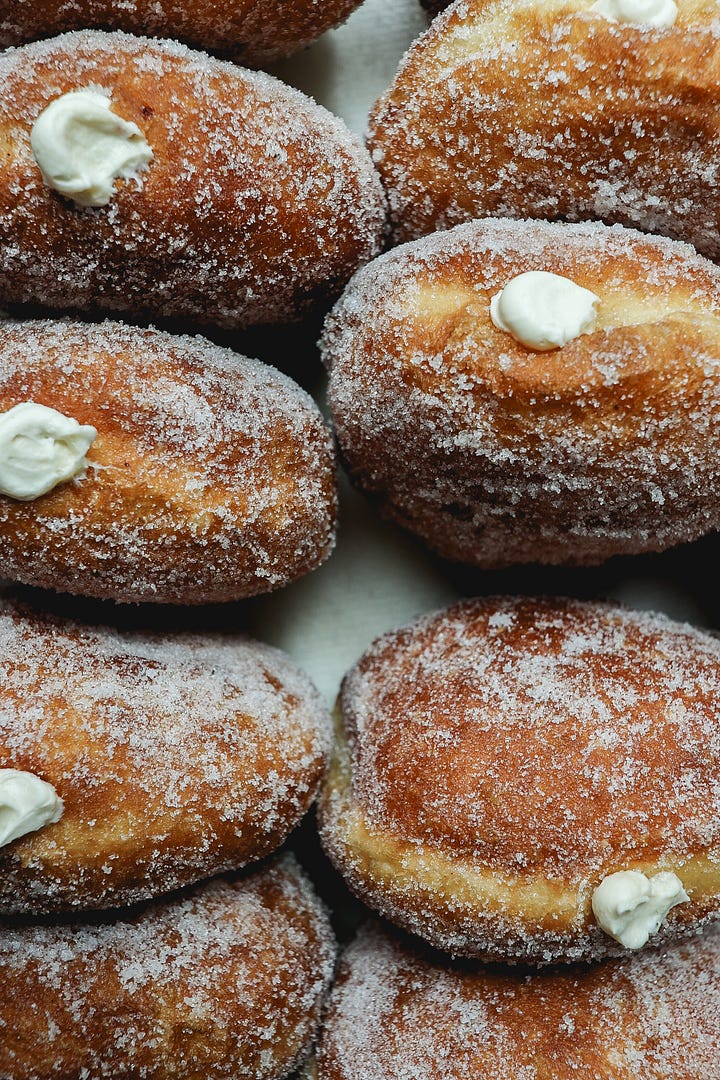
Ingredients:
Tangzhong:
⅓ cup (76 grams) water
⅓ cup (76 grams) whole milk (or plant-based milk like oat, almond, or cashew)
3 tablespoons (25 grams) bread flour
Dough:
¾ cup (190 grams) whole milk (or plant-based milk like oat, almond, or cashew)
5 teaspoons (14 grams) dry active yeast
4 cups (515 grams) bread flour
3 tablespoons (24 grams) buttermilk powder or nonfat dry milk*
5 tablespoons (60 grams) granulated sugar, plus more for coating
1 teaspoon kosher salt
2 large eggs
7 tablespoons unsalted butter, at room temperature
Instructions:
Starting with the tangzhong…
Combine the water, whole milk, and bread flour in a small saucepan, set on low-medium heat, and whisk until smooth and all lumps are gone. Continue to cook (whisking constantly) until thick and the whisk leaves a trail through the mixture. Set aside to cool to room temperature.
To make the dough:
i) In a small saucepan, heat the ¾ cup of whole milk on low, until just lukewarm to the touch. Add the yeast and stir. Set aside to bloom for 5-10 minutes while you prepare the rest of the ingredients.
ii) In the bowl of a stand mixer with the dough hook attachment, mix together the bread flour, buttermilk powder, sugar, and salt. Once the yeast is proofed (it should be foamy at the surface), in a separate bowl, whisk the milk/yeast mixture together with the eggs and cooled tangzhong. Add this to the bowl with the dry ingredients, and knead on low (1-2 on a KitchenAid) until smooth (~10 minutes). Then, with the mixer running, add in the butter one tablespoon at a time. Continue to knead until a smooth, elastic dough forms (another 10-12 minutes).
iv) Transfer the dough to a large oiled bowl (it will be quite sticky still), cover with a towel or plate, and let it rest for 60-90 minutes until almost doubled in size.
v) Once this first rise is done, punch down the dough to deflate it. Cover the bowl with plastic wrap, and let it rest in the fridge for at least 2 hours (and up to 24 hours).
Frying & assembly…
2.5 x 2.5 inch parchment squares (14-18), for the dough balls
1 L neutral/vegetable oil, for frying – the oil should be about 2 inches deep in the pot
1 cup (200 grams) sugar, for coating the finished doughnuts
i) On 2 large cookie sheets/ baking trays, line up and grease the parchment squares. This will make it easier to put the dough into oil, when ready to fry. Take the dough out from the fridge, divide it into 14-18 evenly sized portions (use a scale if you have one). Roll the portions into smooth, taut balls, pinching together any openings– again, use this as a guide, if you need!
ii) Place each dough ball onto a piece of greased parchment, lay a towel or piece of plastic wrap over the top, and allow to rise for 60-75 minutes. If your kitchen is cold or you live in a cooler climate, I’d recommend putting the baking trays into your oven (not turned on!) with a bowl, or two, of just-boiled water. You’ll know the dough is proofed and ready when it’s about doubled in size and bounces back when poked while still leaving a slight indent.
iii) Meanwhile (when your dough is approx. 10-15 minutes away from being finished proofing), heat your oil in a large pot, set over medium heat. Once the oil reaches 350°F on your thermometer, it’s ready for frying. Keep the thermometer attached, to ensure temperature consistency. You’ll likely need to increase or decrease the heat as you’re frying– anywhere between 340°F-365°F is good. Prepare and line a cooling rack, or two, with paper towels, for the just-fried doughnuts.
iv) Lifting with the parchment, gently flip the proofed doughnuts in (2-3 at a time only; don't overcrowd) and fry for 1 ½ - 2 minutes before flipping and frying for another 1 ½ - 2 minutes. They should be golden, puffed, with a “tan line”. Lift each doughnut out using a mesh or slotted spoon (or tongs), and place them on the cooling rack lined with paper towel. Repeat this with the rest of the doughnuts, rolling each doughnut in sugar after 1-2 minutes of cooling. Enjoy while warm, or (even better) allow the doughnuts to cool completely (at least 1 hour) before filling.
Tea-Infused Cream:
Yields: 4 cups (~1 litre) of filling
This tea-infused cream recipe is a canvas for you to be creative with. Pictured throughout this newsletter are versions of the cream made with genmaicha and matcha teas. Any tea will do, the stronger the better.
*This cream is stabilized with gelatine to prevent it from falling flat - it will hold up in your doughnuts for a day after filling, but its best to fill and serve them right away or within a couple of hours to prevent the doughnut itself from getting too moist.
Ingredients:
500mL (2 cups ) 35% cream
50g (1/4 cup) white sugar
1/8 tsp salt
2 tbsp of your favourite dried tea leaves (or 2.5 tsp of matcha powder*)
1 tsp powdered or 2 sheets gelatine
Instructions:
1. Add the cream, sugar, salt, and tea leaves to a saucepan and place on the stove over medium heat (if using matcha, leave it out for this step). Bring the cream to a simmer for a minute, whisking to dissolve the sugar, then remove from the heat. Allow the tea to steep for at least half an hour, and up to several hours for a stronger flavour.
*If using matcha, place the matcha powder in a small bowl and add 2 tbsp of the hot cream mixture. Use a matcha whisk to whisk until no clumps remain. Add this back into the pot with the cream and whisk to combine. Proceed to step 2 right away.
2. When your tea is sufficiently steeped, strain the tea leaves out. Place the pot with the steeped cream back on the stove and bring it to a simmer once more. If using sheet gelatine, submerge it in cold water while your mixture heats up. Once hot, add the powdered gelatine or drained sheet gelatine to the pot and whisk until it is completely dissolved. Then, pass the mixture through a fine sieve into the bowl of a stand mixer (or any large bowl if you are using a handheld mixer) and place it in the refrigerator to cool completely.
3. Once cold, use the whisk attachment to whip the cream until it is light and holds a peak, about 3 minutes, then transfer it to a piping bag with a round tip (or a plastic ziplock bag).
4. To fill the doughnuts, use a paring knife to make a small, roughly 1.5 cm cut into the sides of each doughnut. Stick the tip of the piping bag into the opening and squeeze in the cream until there is no more room, repeat with the remaining doughnuts.


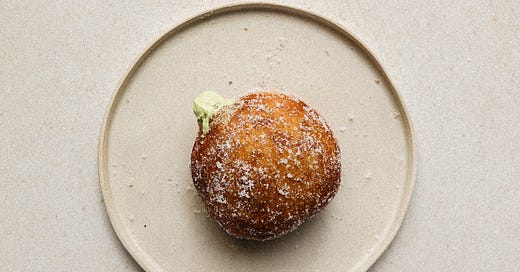




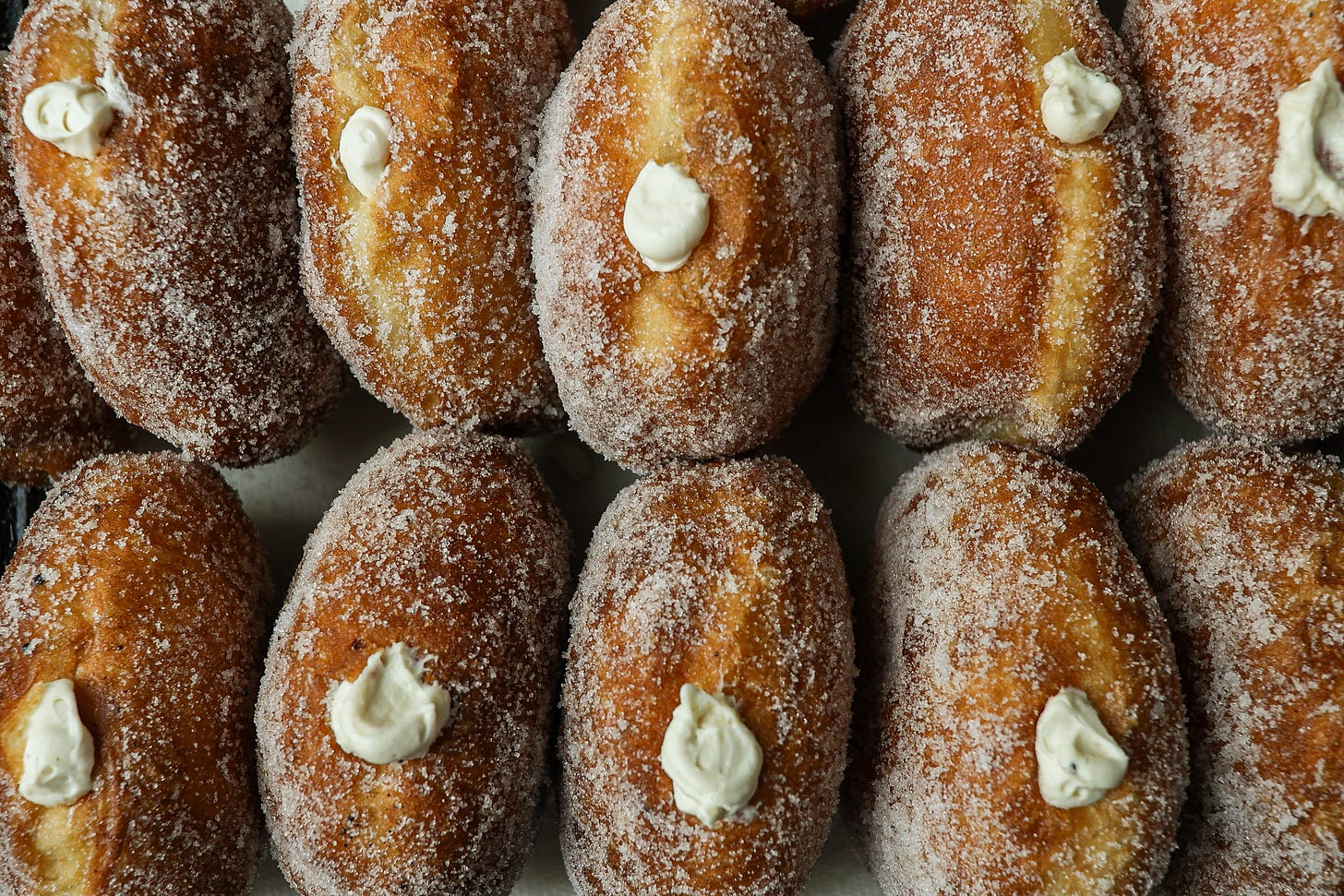
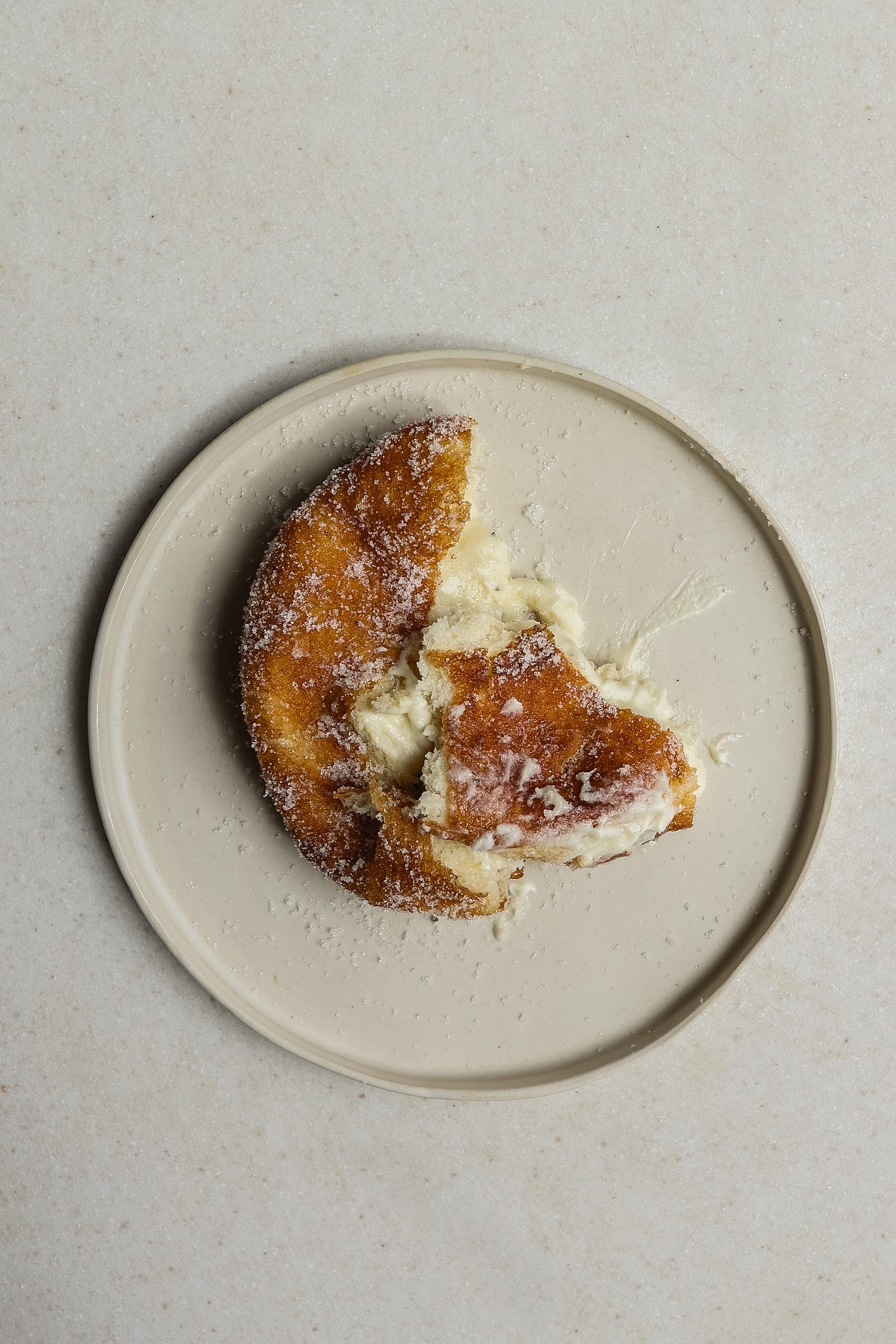

Love this! I’m Harrison, an ex fine dining industry line cook. My stack "The Secret Ingredient" adapts hit restaurant recipes (mostly NYC and L.A.) for easy home cooking.
check us out:
https://thesecretingredient.substack.com
I made this recipe for a friend's birthday with earl grey tea and it was truly perfection! would definitely make again!!